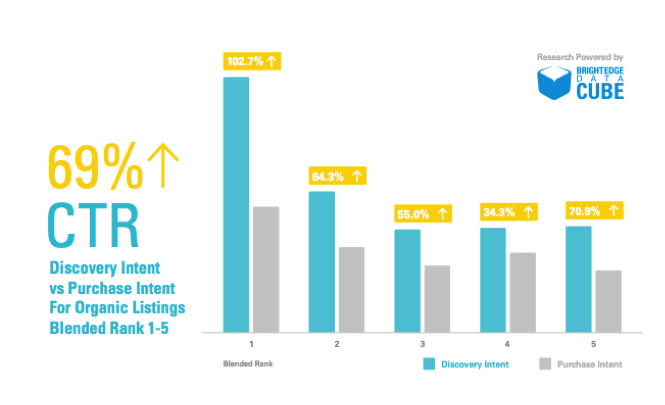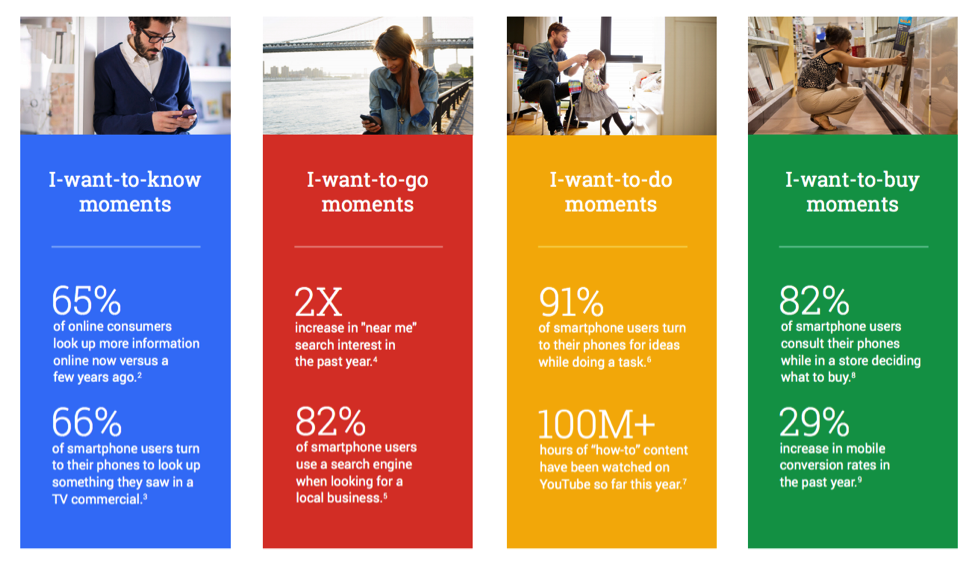The changing SERP: understanding and optimizing above and below the fold
Google SERPs continue to change regularly to better reflect the needs of the end-user. For brands to successfully attract organic traffic, they need to be able to keep up.
Google SERPs continue to change regularly to better reflect the needs of the end-user. For brands to successfully attract organic traffic, they need to be able to keep up.
Google SERPs continue to change regularly to better reflect the needs of the end-user. For brands to successfully attract organic traffic, they need to be able to keep up.
Considering that our research at BrightEdge shows that an estimated 51% of the traffic to your site arrives through organic, the changes in the SERPs remain a pressing concern for all brands.
The position of a result on the SERP, as well as the different rich results that appear at the top, all impact how many clicks each website receives.
What customers want to see when they type in a particular query will heavily influence where they click and the types of results that will satisfy their needs.
Google has been working to better understand intent so they can improve their user satisfaction. Brands that are able to similarly cultivate their understanding of user intent will therefore see improved positioning in the SERPs and present greater appeal for the users themselves.
Google attracted considerable attention for their changes to the SERP earlier in the year when they removed the ads along the side bar and increased the allowed space for the ads above the organic results on certain queries.
What brands need to be paying even more attention to, however, is the increased emphasis by Google on the intent-focused SERP.

We have all been seeing signs of this for years. Google interprets certain queries as being indicative of certain desires. That is why when you phrase your query one way, you might get images of the keywords, but another might get you the local 3-pack.
Lately, Google has also been drawing our attention to the idea of micro-moments.
Micro-moments occur when people reflexively turn to a device increasingly a smartphone to act on a need to learn something, do something, discover something, watch something, or buy something. They are intent-rich moments when decisions are made and preferences shaped. This is all according to Google.
It is important to see this shift not just as another optimization checklist, but rather a new worldview in the arena of SERP and optimizing keywords.
Brands that learn how to operate within the intent-focused SERP, taking micro-moments into account as they design their strategies, will be able to harness more traffic, revenue, and reach than those that do not.
This new system requires brands to understand their users on a more intimate level so they can design their strategies and their sites to better address their needs.
Google has been working to create SERPs that align with user intent for a while. The recent emphasis on the micro-moment has taken this a step further.
Google focuses on four main types of micro-moments that brands should familiarize themselves with to succeed.
Google is working to understand what people seek when they type in queries that fall into one of these categorize. T
hey then answer these queries using any one of a number of different combinations of features such as maps, PPC, organic results, and images.
Google also recently introduced the new AMP pages, the quickly-loading mobile pages that help to provide users with rapid answers while on the go. The push for news-oriented sites to markup their pages for AMP reveals the dedication of Google to improve the I-want-to-know micro-moment experience.

Source: https://think.storage.googleapis.com/docs/4-new-moments-every-marketer-should-know.pdf
They have also recently been experimenting with different rich cards and answer boxes along the top for certain queries.
Recipes, for example, which presume an “I-want-to-know” moment, will display an answer box with a popular recipe and image at the top.
It is also interesting to note the difference between the queries “bedroom ideas” and “how to decorate a bedroom.” “Bedroom ideas” is viewed by Google as more of an I-want-to-know moment, with images featured on the SERP. When you add in “how to decorate”, however, Google starts to include ads along the top in addition to an answer box, appealing to those who are interested in purchasing furnishings.
For websites to function within this intent-focused SERP, they need to use hybrid marketing departments.
PPC and SEO people need to be able to come together to create an online presence that will be displayed favorably on the search results pages above and below the fold.
They can use the right times to develop different types of content to ensure that their material is meeting the intentions of users. The better users are able to understand user intent with the different micro-moments, the better they will be able to prepare their sites and their content to appear well on the various SERPs.
Brands need to become intimately familiar with what people are likely looking for when they are in these high-intent moments. Look at your consumer data, particularly your mobile data, and what brought people to your site, what types of people converted, and what types of content were most successful.
Consider all the types of micro-moments that will apply to your business in different situations. A retailer, for example, might want to focus most of their energy on the I-want-to-buy moment and the I-want-to-go moment if they have a brick-and-mortar store in addition to online listings.
They should not neglect, however, the I-want-to-know moments that might appeal to users early in the buyer’s journey.
These keywords should be carefully selected through keyword research that lets you uncover popular terms that will be used by your prospects throughout their buyer’s journey.
Consider the micro-moments that will impact your visitors most strongly at the various stages of their journey. For example, those in the early stages are likely to land on your site through, “I-want-to-know’ moments, while those at the end will be more impacted by the “I-want-to-buy” micro-moment.
See if there are local 3-packs and maps appearing, how many ads show up, and the number of organic results that appear, to name a few. The more insight you have into how the SERP is displayed, the easier it will be to develop a targeted digital strategy.
While all content should go through basic SEO optimization to maximize organic ranking, you also need to find the optimal opportunities to buy paid ads for above the organic results as well as optimizing for Quick Answers, Google Local, and images.
By making sure you have optimized the right aspects of the content, you can be confident that it will rank as highly as possible while also appealing to the visitor by understanding their needs and wants in the moment.
With the emphasis on optimizing for the entire SERP above the fold, your brand needs to bring these different departments of search engine marketing together. They will need to work together to understand what users are looking for during particular micro-moments and meeting customers where they are.
Google is continually adjusting their SERP to make it more aligned with intent-focused marketing. They want the sites listed to address customers’ needs in the moment. Those that are able to do this will be rewarded on the new intent-focused SERP layouts.
By carefully analyzing the micro-moments and the ones that apply most to their customers, brands can start to optimize their material for visitor intention and see greater success from the search results pages.
Leave a Reply
You must be logged in to post a comment.